Hi all, I know this question looks similar to some others but I have trawled through them extensively and can't get them to work for me.
I have 16 datasets, let's call them 1 to 16. I would like to iterate through every possible different way of collecting these 16 into 4 groups; the most basic example being : [1,2,3,4][5,6,7,8][9,10,11,12][13,14,15,16].
The Question is how can I best iterate throught these combinations (in vba)?
Below I have provided a more detailed example to help illustrate what I am trying to achieve, my thought proccesses to date, the code I have tried, and why it hasn't worked.
Example Another valid combination could be [2,4,6,8][10,12,14,16][1,3,5,7][9,11,13,15], etc etc. However, I would like to avoid any duplication: a type one duplication would include elements repeated within a group, or another group of the same combination: [1,2,2,4]... OR [1,2,3,4][4,5,6,7]... A type 2 duplication would involve the same groups as a previous iteration, for example [1,2,4,3][5,6,8,7][9,10,12,11][13,14,16,15].
Thought Process I would like to avoid any duplication, especially as this will massively cut down the number of combinations I will have to compare. I have tried to avoid type 1 by using a function that compares all the elements in a combination to see if any are the same. I have tried to avoid type 2 by ensuring the elements in each group are always in ascending order, and ensuring the first element from each group is always in ascending order too. (This should work shouldn't it?)
Code Below are two examples of code I have tried. The first one simply crashed excel (I did have a value instead of large number if that's what you're thinking); I'd imagine there are just too many combinations to go through one by one? The second doesn't give me unique groups, it returns the same groups with only the first value in each one changed.
1.
Sub CombGen()
Dim Combs(1 To 1820)
Dim Comb(1 To 4)
Dim GroupsCombs(1 To *large number*)
Dim GroupsComb(1 To 1820)
x = 1
For a = 1 To 16 - 3
Comb(1) = a
For b = a + 1 To 16 - 2
Comb(2) = b
For c = b + 1 To 16 - 1
Comb(3) = c
For d = c + 1 To 16
Comb(4) = d
Combs(x) = Comb
x = x + 1
Next d
Next c
Next b
Next a
x = 1
For a = 1 To 1820 - 3
GroupsComb(1) = a
For b = a + 1 To 1820 - 2
GroupsComb(2) = b
For c = b + 1 To 1820 - 1
GroupsComb(3) = c
For d = c + 1 To 1820
GroupsComb(4) = d
If Repeat(a, b, c, d, Combs) = False Then
GroupsCombs(x) = Comb
x = x + 1
End If
Next d
Next c
Next b
Next a
End Sub
Function Repeat(a, b, c, d, Combs)
Repeat = False
Dim letters(1 To 4): letters(1) = a: letters(2) = b: letters(3) = c: letters(4) = d
Dim i: Dim j
Repeat = False
For x = 1 To 4
For y = 2 To 4
For i = 1 To 4
For j = 1 To 4
If Combs(letters(i))(x) = Combs(letters(j))(y) Then
Repeat = True
End If
Next j
Next i
Next y
Next x
End Function
2.
For a = 1 To 16 - 3
For b = a + 1 To 16 - 2
For c = b + 1 To 16 - 1
For d = c + 1 To 16
TempGroups(1, 1) = a: TempGroups(1, 2) = b: TempGroups(1, 3) = c: TempGroups(1, 4) = d
For e = 1 To 16 - 3
If InArray(TempGroups, e) = False Then
For f = e + 1 To 16 - 2
If InArray(TempGroups, f) = False Then
For g = f + 1 To 16 - 1
If InArray(TempGroups, g) = False Then
For h = g + 1 To 16
If InArray(TempGroups, h) = False Then
TempGroups(2, 1) = e: TempGroups(2, 2) = f: TempGroups(2, 3) = g: TempGroups(2, 4) = h
For i = 1 To 16 - 3
If InArray(TempGroups, i) = False Then
For j = i + 1 To 16 - 2
If InArray(TempGroups, j) = False Then
For k = j + 1 To 16 - 1
If InArray(TempGroups, k) = False Then
For l = k + 1 To 16
If InArray(TempGroups, l) = False Then
TempGroups(3, 1) = i: TempGroups(3, 2) = j: TempGroups(3, 3) = k: TempGroups(3, 4) = l
For m = 1 To 16 - 3
If InArray(TempGroups, m) = False Then
For n = m + 1 To 16 - 2
If InArray(TempGroups, n) = False Then
For o = n + 1 To 16 - 1
If InArray(TempGroups, o) = False Then
For p = o + 1 To 16
If InArray(TempGroups, p) = False Then
TempGroups(3, 1) = m: TempGroups(3, 2) = n: TempGroups(3, 3) = o: TempGroups(3, 4) = p
If *comparison criteria are met* Then
For x = 1 To 4
For y = 1 To 4
Groups(x, y) = TempGroups(x, y)
Next y
Next x
End If
End If
Next p
End If
Next o
End If
Next n
End If
Next m
End If
Next l
End If
Next k
End If
Next j
End If
Next i
End If
Next h
End If
Next g
End If
Next f
End If
Next e
Next d
Next c
Next b
Next a
End If
Groups and TempGroups are 2D arrays, the first value being the group number and the second being the element number in that group.
InArray is a function I made (fairly self explanatory)
In this instance, I am using a comparison criteria to compare the most recent "best" set of groups with the current iteration of "tempgroups" and saving the best one, ready to be compared to the next iteration
Links that didn't help:
How can I iterate throught every possible combination of n playing cards
While this was useful, it only looked at the combinations of one group within the set, I would like to look at the combinations of multiple groups within the set
Listing all permutations of a given set of values This looked more at permutations (rearranging the order of groups as opposed to the combinations)
Pretty much all the other solutions I looked at fell into one of these categories






